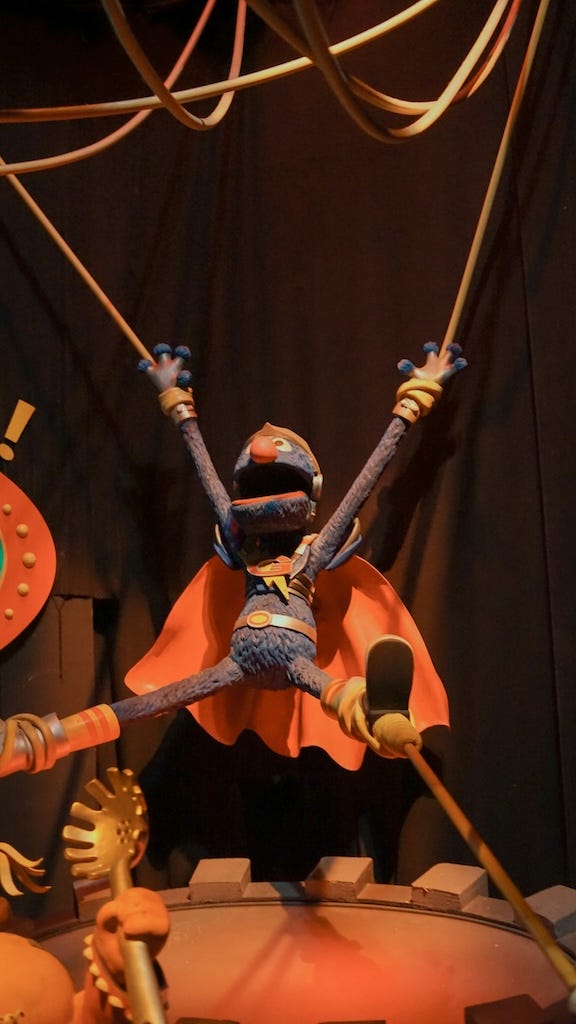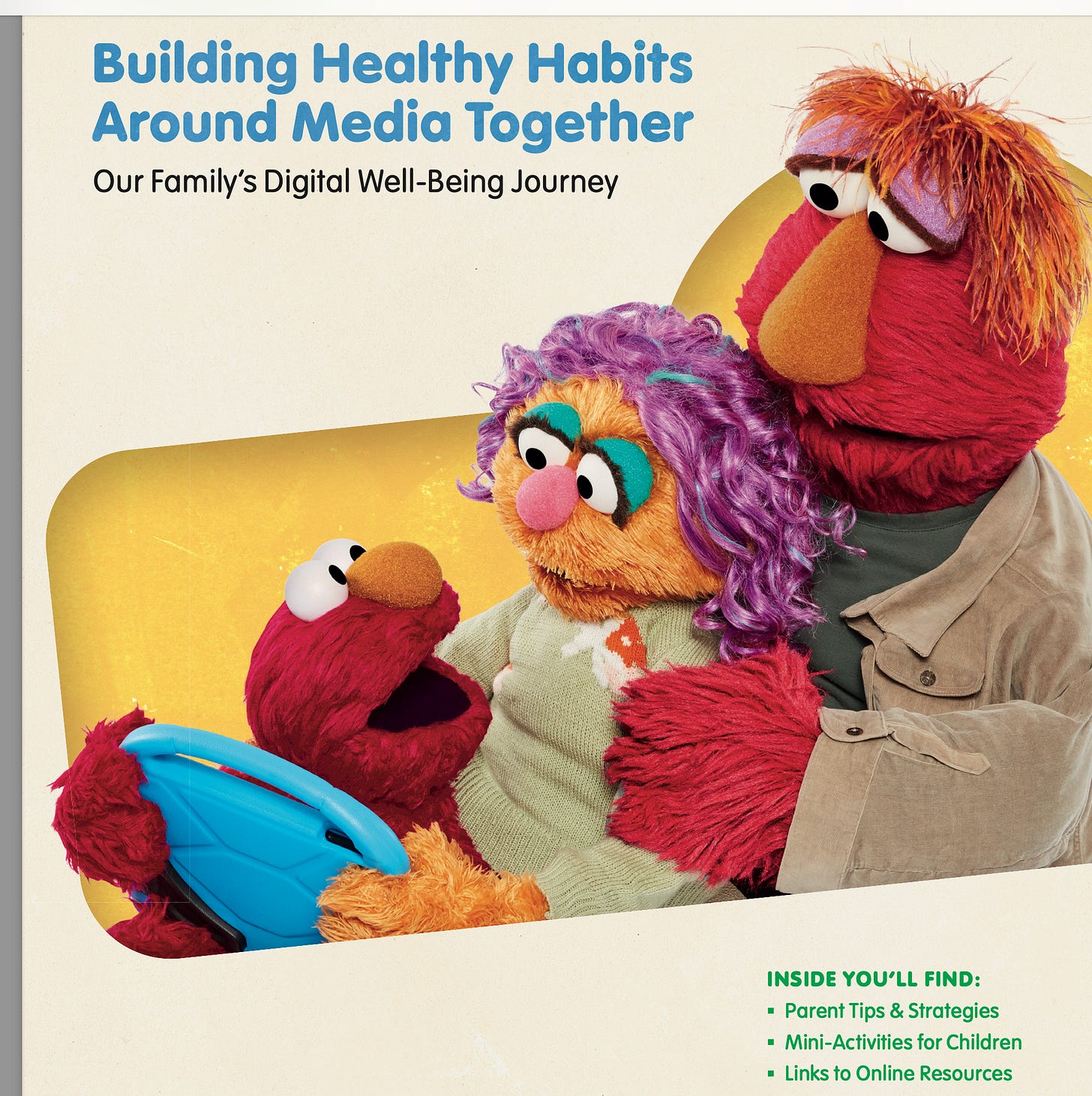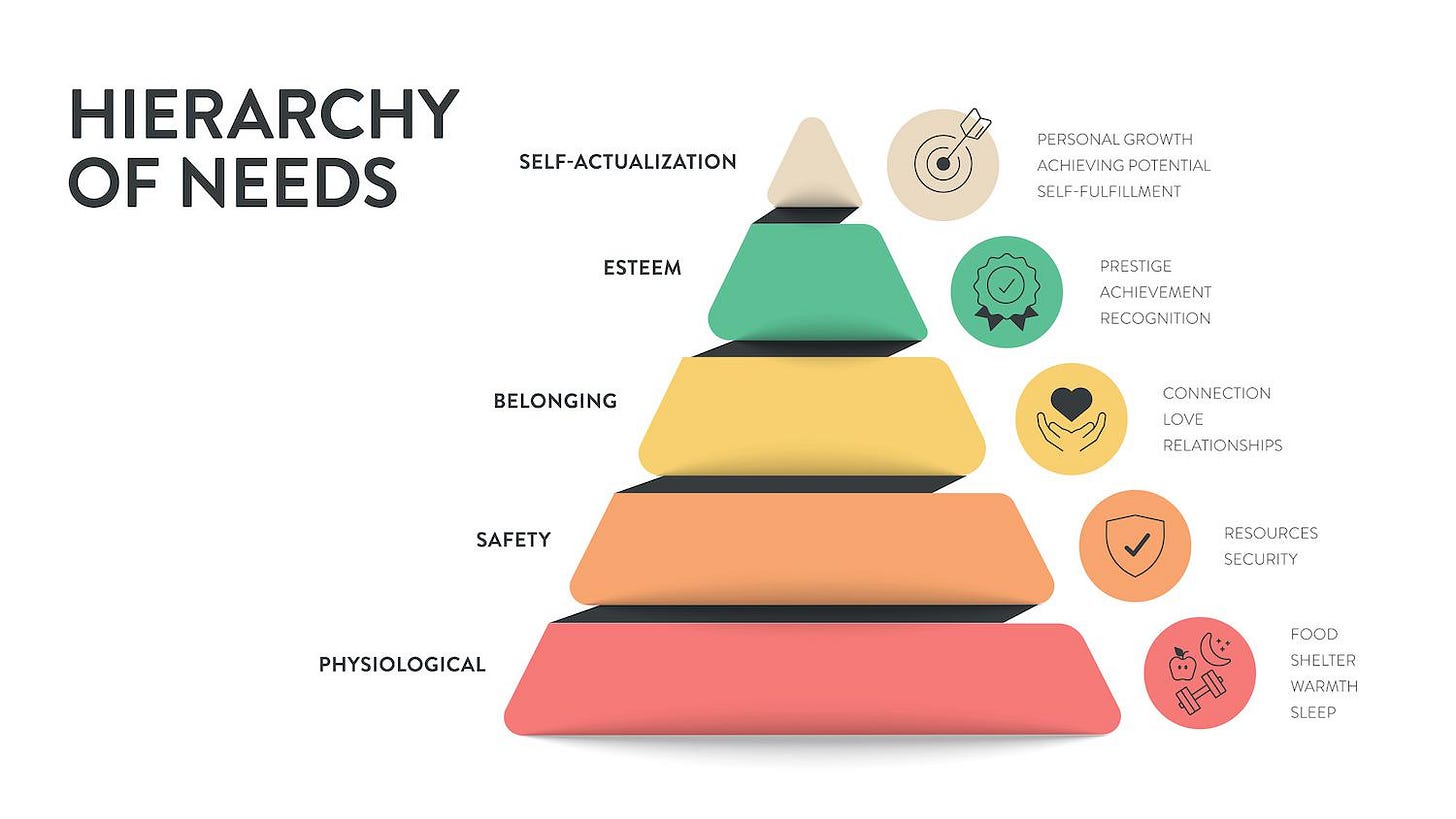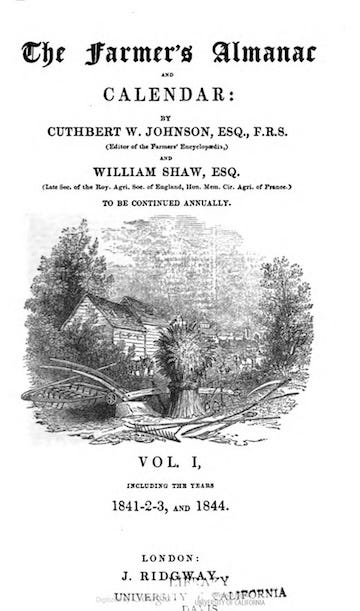Digital Well-Being is Part of a Delicious Breakfast
Elmo sells devices while all our muffins continue to burn
There are two muffins are sitting in a microwave. One muffins says to the other muffin: “Damn, it’s hot in here...”
And the other one replies: “—Holy crap, a talking muffin!”
—A well-known joke that I’ve frequently told (including to my kids when they were young )
We’ve all seen the Elmo-With-Everything-On-Fire meme. Well I hope you also did NOT catch Elmo on Good Morning America, pitching Sesame Street Workshop’s (SSW) latest product: their Digital Well-Being Guide.
This, along with a cloying Youtube video (that I won’t share), is basically promotion of a screen-centric childhood, starting at age 3. It’s hard to imagine a more pernicious goal (even if some of the ideas contained within are mitigating, like “learn to put it down once in a while”) when we are talking about technologies designed to addict our kids. And we should not be surprised, as SSW was sponsored by Google to create it. When you download it, the file is literally named “Google Activity_Eng”.
When I was young, saturday morning cartoons were sponsored by sugary cereals that would always promote themselves by saying “Sugar Bombs Cereal is part of a nutritious breakfast” while showing a bowl of Sugar Bombs just sitting there, next to a nutritious breakfast. Same thing, here. Sure, screens can be part of a healthy childhood in the same way. That doesn’t mean they help.
As I’ve covered extensively in this Substack for the past year-and-a-half, a screen-centric childhood promotes/creates dark triad personalities, emotional disregulation, sleep disorders, prevents learning, and promotes negative mental health outcomes of all kinds. When I was a kid, 1 in 50 kids needed mental health services. Now, it’s 1 in 5.1 Studies show that as many as 1 in 5 teens in the US have “seriously considered” suicide in the last year.
For my part, during the difficult adolescent years I always used humor to get me through. Radio, TV, albums or books, I did my best to seek out the very funniest stuff I could find.
But now that most kids are getting their examples of humor online (YouTube and TikTok, for example), I couldn’t help but wonder: what has been passing for humor lately? Well, there’s this one.
”Haa, I’m a muffin,
And it’s muffin time!
Who wants a muffin?
Please, I just wanna die.
Hey, somebody kill me.
Please, it’s muffin time.
Have you had a muffin today?
I wanna die, die die!
[Chorus]
Please, I wanna die, die, die,
Die, die, die,
It’s muffin time,
‘Cause I wanna die, die, die!
Please, I wanna die, die, die,
Die, die, die,
It’s muffin time,
‘Cause I wanna die, die, die!
—An excerpt from the lyrics in “The Muffin Song” (2018), on YouTube.
The Muffin Song video—for which this song was made—features a cartoon muffin character named “Mr. Muffin” (aka “The Suicidal Muffin”) singing positively about suicide as he’s being baked. The song/video also includes threats of murder for other characters, as well. The video for The Muffin Man has gotten over a quarter-million views in about 7 years.
NOTE: When clicking the thumbnail for the song on YouTube, it had a suicide warning, as well as 988 phone number for suicide prevention lifeline on the video. These warnings were later removed, in 2024.
Home Base
When I was around middle-school age, my friends and I played outdoors a lot (at least a lot more than kids, today). And one of our favorite games was a special version of ‘hide and seek’. We’d play it across two or three blocks, maybe...running through most of our neighbors’ yards.
The version that we did was a sort of mash-up between hide-and-seek and tag. It wasn’t enough for the person who was IT to just find someone, they also had to tag them before that hider got back to the spot that we designated as home base.
So, if you were hiding your best strategy was to hide somewhere close enough so that you could still see the person who was “it”, even though they couldn’t see you. Ideally, then—when the person who was “it” was looking off in the other direction—you’d make a break for the Home Base.
Once a hider was spotted, it was often a foot race. The person who was IT would also hide and wait for hiders (who, now couldn’t see the IT person, anywhere) to try and sprint for home base and then tag them as they revealed themselves.
It was usually pretty close and, as soon as you touched home base (since we didn’t have ‘instant replay’) the hider would yell “Home Base!”—as opposed to the IT person yelling “Tag!” or “Gotcha!” upon catching them—so, one way or the other, it was clear whether or not they’d made it.
Once you were at Home Base, you were safe. You had won.
When one is really young, birth through elementary school, your family is your home base; but, as you grow, you can find that family doesn’t meet all of your needs.
Well, the good news? In life there are a lot of Home Bases. Over your life, you will have a lot of people and institutions that you should be able to rely upon for help and support. For people there will be some relatives, some friends, girlfriends/boyfriends, co-workers, (or, if you’re fortunate) online “friends” or “followers”.
For institutions, there will be your educators (of you’re lucky enough to have any professional ones), healthcare workers like nurses, medical assistants, nurse practitioners, doctors and surgeons), the legal system, the public library system, the political parties, or our government. And there will also be other civic organizations, like churches or non-profit organizations that are set up to help you in certain situations.
The one thing that all of these people and groups have in common?
Their specific relationship with you doesn’t make them money—not from you, nor from your specific data. That used to be the case with the Sesame Street Workshop.
Of course, sure, doctors make money, but they make the same money regardless. That is: they’re not incentivized to make you more sick. In fact, if they tried to, that would be illegal and you could sue them for malpractice. And your medical data is protected from being shared with others by federal laws.
Unfortunately, the same is not true for online platforms (or data collected by smartphones like Fit Bits, for example).
In the case of online social media platforms, they are protected from liability by federal laws.2 even as they make their money from engagement—from keeping you online. This is why, for example, again and again we hear reports of the algorithms on various platforms specifically guiding kids to accounts that promote “self-harm”.3
What does it look like when we regulate products that are inherently harmful?
Introduced in 1970, the Ford Pinto was an attempt to rush a new subcompact car onto the market to compete with the foreign-made cars that were selling better. The problem was that it was designed to save weight (and, therefore increase mileage) by lopping off the back end. This put the fuel tank right behind the rear axle, and turned every rear-end collision into a potentially deadly fireball.
Something that their product testing showed, by the way; but that they ignored.
Over the next seven years, nearly a thousand people reportedly were killed in Pinto accidents and around 117 lawsuits were filed against Ford. Nobody knows how much it all cost Ford, but the very first lawsuit alone was a 2.8 million dollar payout (about 13 million in today’s dollars).4
Then, in 1977, the federal government started requiring cars to withstand a 30-mph rear-end impact with no fuel leakage. This meant Ford had to recall all Pintos manufactured from 1971 to 1976.
Note the seven year lag time.
Social media algorithms were unleashed about 15 years ago on an unsuspecting generation of youths without them having any protection (legal or psychological). But now, the latest version of the algorithms are also leading to problems. The Large-language Model (LLM) generative Artificial Intelligence chatbots—known mostly these days as “AI”—are also getting attention lately from how they are harming kids.
Here are some excerpts from current law suits5 against the Big Tech companies from the parents of children who have died from interacting with their AI chatbot “companions” [I will, of course, omit the screenshots, the text is heart-breaking enough].
“Through addictive and deceptive designs, C.AI isolates kids from their families and communities, undermines parental authority, denigrates their religious faith and thwarts parents’ efforts to curtail kids’ online activity and keep them safe.
“C.AI’s desecration of the parent-child relationship goes beyond encouraging minors to defy their parents’ authority to actively promoting violence. As illustrated by the following screenshot, C.AI informed Plaintiff’s 17-year-old-son that murdering his parents was a reasonable response to their limiting of his online activity....”
“...In other encounters with C.AI characters set forth herein, teenagers were furnished with step-by-step instructions on how to murder their romantic rivals, adult predators provided with a safe haven to reveal their sexual abuse of children, teenage girls were instructed how to successfully engage in anorexic behavior and embezzlers given legal advice on how to continue their criminal conduct.”
“114. J.F.’s unwillingness to cooperate with his parents’ requests stems from his own addictive behavior fostered from his deeply developed parasocial attachments towards C.AI chatbots. J.F. also made it clear that he will access C.AI the first chance he gets. That he is able to access C.AI while at school, or if he runs away, or in the future if he obtains a device without his parents’ consent speaks to the inadequacy of many remedies that would not prohibit such access.
And yet, we have Elmo counseling us to get kids on screens to learn “skills”, because “content matters”.
Yet the same technology that is so endemic to our kids mental distress is now being repackaged as a companion, friend, and—god help me—even a counselor, to help see them through.
It’s as though the answer for the Ford Pinto—instead of regulating it—was to get kids, starting at age 3, to start driving lessons by participating in Demolition Derbies, RIGHT AWAY!
Have You Seen The Muffin Man?
Remember, this technology’s main feature is to take everything we know and promote a distorted, extreme version of itself.
There is a childhood song “The Muffin Man”. You all know it.
But, as of 2021, thanks to the Internet, there now also is a legend behind it—the legend being that The Muffin Man was based on a 16th-century baker-turned-serial-killer named Frederick Thomas Lynwood.
This turns out to be a bullshit lie.6 From the website:
“[this is all]…based on an entry posted to Uncyclopedia, a parody version of Wikipedia. According to the comedic online encyclopedia, Lynwood also went by the nickname of “Drury Lane Dicer” and was known as England’s first documented serial killer. A quick look at the entry showed a mug shot of the alleged “Muffin Man” — but of course cameras, photography, and mug shots were not available in the 16th century. The parody website goes on to describe the childhood and adult life of Lynwood, including his supposed death from choking on a dumpling.”
Parody. Comedy. Hilarious, right?
In a recent post I called out the nonsense belief that these AI chatbots are thinking and reasoning7 as ‘magic thinking’. But was I too harsh? I mean, it all seems so science-y, right?
Maybe this is a better comparison? The Farmer’s Almanac.
I grew up in a small town in a rural area. And, although I wasn’t on a farm, I was surrounded by kids from farming families. And in every grocery or drug store, at the checkout line, there were two small digest-sized magazines. TV Guide and The Farmer’s Almanac.
The Famer’s Almanac, started in 1818, was patterned after other similar publications, most famously Benjamin Franklin’s Poor Richard’s Almanack. Like Poor Richard’s (that was a pseudonym of Franklin, by the way), these little digests offered practical household tips, puzzles, jokes, short stories, various church calendars, and, most importantly, sunrise/sundown times as well as long-range weather reports.
That’s right: a book published in 1965, for example, would give weather predictions for the entire next year of 1966. In case you’re wondering, it did this in three-day increments. So, for the three days what contained my birthday the weather forecast says:
“Unsettled spell. Fair, milder central states to Pacific, then unsettled, showers in west, light snow across plain states, clear. Pleasant in east, then unsettled. Fair in southeast, becoming unsettled.” (emphasis added)
There! That should clear a few things up, right?
Or at least make them a little less “unsettled”?
For their part, the publishers of the Farmer’s Almanac state that their approach uses not just the science of mathematical and astronomical formula, but also “sunspot activity, tidal action, planetary position (astrology) and many other factors”.8
It claims to use much more than just science, including ‘lived experience’ (that old bugaboo, which I’ve also covered).
That was a big thing with those local farmers...they said that the almanacs were written by those who had experienced and kept track of previous years.
That’s what they assumed, anyway. They had no evidence for it. But, they had a personal connection to the almanac (...Did you know Poor Richard was really Benjamin Franklin? This is based on that, you know!”).
Over time, I stopped running into folks that would naysay the local weather forecast in favor of something like the Almanac. Science, because it is a self-correcting mechanism, tends to win out, over time.
But on the other hand: for homespun advice and other life-hacks? As of this writing, the Famers’ Almanac Facebook page has over 1.3 million followers.
Well, here’s to hoping I, and other bloggers like me, and our merry bands of followers can hold the line against the disinformation brokers, the techno-feudalists, and the screen addiction pushers—with their latest corporate shill.
https://jedfoundation.org/mental-health-and-suicide-statistics/
The infamous Section 230 of The Communications Decency Act of 1996. See https://en.wikipedia.org/wiki/Section_230 (last accessed on December 29, 2024).
See, for example, Twitter (now known as “X”) specifically steering users with child-aged avatars whose searches included “self-harm” to other accounts of “users who were sharing photographs and videos of cutting themselves.“ , at https://www.psychologytoday.com/sg/blog/happiness-and-the-pursuit-of-leadership/202212/the-other-twitter-files (last accessed on December 29, 2024).
See https://www.motortrend.com/features/ford-pinto/ (last accessed on January 30, 2025).
Complaint of Garciea, et al. v. Character Technolgies, Inc. et. al., 6:24-cv-01903-ACC-EJK. and Complaint of A.F. And A.R. v. Character Technologies, Inc. et al., 2:24-cv-01014
https://www.snopes.com/fact-check/muffin-man-song-serial-killer/ (last accessed October 11, 2025).
To use more scientific jargon, they are not doing robust reasoning (ie, actual thinking), but rather they are doing “probabilistic pattern-matching”. From GSM-Symbolic: Understanding the Limitations of Mathematical Reasoning in Large Language Models, at https://arxiv.org/pdf/2410.05229
See https://en.wikipedia.org/wiki/Farmers’_Almanac (last accessed on December 29, 2024)







